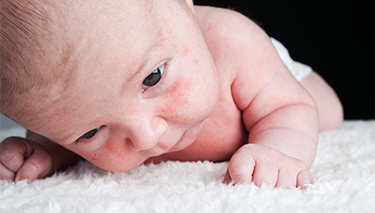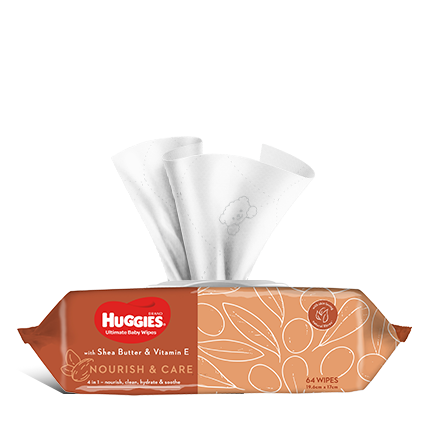It can be more than just a little distressing when a baby has nappy rash for them and the people who love them. And in some strange way, many of us still view nappy rash as a sign that we're not doing all we can to care well for our babies. But nappy rash has many causes, many have nothing to do with infrequent nappy changes or hygiene. There are a few reasons and risk factors, such as pre-existing skin conditions which can make nappy rash more common.
It can be helpful to know how to prevent nappy rash in the first place and if necessary, treat it so it doesn t get any worse.
What is nappy rash?
Nappy rash is a rash which affects the baby's skin covered by a nappy. It can range in severity from a very mild pink discolouration of their skin to blisters or red bleeding lesions. Nappy rash can be confined to one small patch of skin, or it can spread all over the nappy area. When the skin is cleaned and wiped, this can cause discomfort or itching and the baby can protest.
Nappy rash can crop up between nappy changes or be present for days or even weeks at a time. Sometimes nappy rash can be difficult to treat effectively e.g., if there is an underlying thrush or bacterial infection. Specific treatment is necessary to treat the cause otherwise nappy rash does not improve.
What causes nappy rash?
- Sensitive skin which reacts easily when exposed to wee or poo. Both contain ammonia and this can cause the skin to become irritated and a rash to develop.
- A thrush infection, caused by Candida Albicans, a yeast which thrives in warm, moist areas. Mothers with vaginal thrush can pass on the organism during vaginal birth.
- A breakdown in the integrity of the baby's skin. Friction can cause increased irritation.
- Particular foods causing a skin reaction.
- Medications such as antibiotics.
- Reactions to baby wipes, creams or nappies.
- Infrequent nappy changing.
- Not cleaning all the wee and poo from the baby's skin.
Nappy rash is generally caused by the baby's wee or poo applying moisture against the baby's sensitive skin. Nappies and clothing cause friction, causing their skin to react, becoming red and sore.
Teething nappy rash
Many babies develop a nappy rash when they are teething. The cause for teething nappy rash is unclear, though many babies seem to be generally more sensitive when their teeth are erupting. The treatment for teething nappy rash is the same as for any other time. Frequent nappy changing and applying a good quality barrier cream will help. Avoid your baby's skin coming in contact with wee or poo for any longer than necessary.
Potential complications of nappy rash
Any breakdown in the integrity of the baby's skin can lead to an infection. Antibiotic cream is sometimes needed if a bacterial infection is causing the nappy rash. If severe and left untreated, nappy rash can cause a systemic infection and the baby may need oral antibiotics.
Nappy rash is generally not painful but it can be irritating and cause the baby to be unsettled.
Preventing nappy rash
- Change your baby's nappy often and use a good quality barrier cream on their skin.
- Warm the cream between your fingers before smearing it on your baby's skin. This will help the cream to go on more gently and not drag their skin.
- Use warm water or gentle, hypo-allergenic wipes to clean your baby's skin. Dry their skin with a soft cloth before you put a clean nappy back on.
- Wash your own hands after you change your baby's nappy.
- Avoid using bubble baths and strong-smelling washes and soaps on your baby's skin. Instead, use a mild baby wash or soap which matches their skin's pH 6.3-7.5.
Nappy rash treatment
Generally, nappy rash clears in a couple of days. Nappy rash treatments can range from the general e.g., more frequent changing, to prescribed creams/ointments.
- Change your baby's nappy regularly. At least 6-8 nappy changes each day is the minimum.
- Use water or gentle, non-irritant wipes to clean your baby's skin every time you change their nappy.
- Be very careful that you're cleaning the folds of their skin and removing all the wee and poo.
- Use a gentle barrier cream after cleaning your baby's skin.
- If your baby is a boy, don t try to retract the foreskin.
- Give your baby some time each day to kick freely without their nappy on.
- Make sure you're using the right size nappy for their age and weight. Nappies which are too tight can cause rubbing and friction.
- Avoid using plastic pants (pilchers) outside cloth nappies.
- Don t use antiseptic wash or wipes on your baby's nappy rash. Both will aggravate their skin even more.
- Anti-fungal creams or ointments target the yeast organism which is causing a fungal rash.
- Anti-inflammatory creams such as Hydrocortisone remove redness and sensitivity. You will need to speak with a doctor and/or pharmacist before using prescribed creams.
When to see a healthcare professional
- If your baby's nappy rash is not clearing after few days.
- If the rash is spreading or getting worse.
- If the rash is spotty and looks like small pimples. A thrush infection can create redness, with shiny bright red patches and pimples around the edges. Anti-fungal creams can be bought from a pharmacist without a prescription.
- If the nappy rash has any blisters or crusts.
- If your baby has a temperature or seems unwell.
- If your baby is bothered by the rash.
- If there are any changes in your baby's behaviour, their feeding or their sleep.
5 top tips on how to treat nappy rash
- Change your baby nappy frequently every time they wee or poo.
- Use good quality disposable nappies which will help to draw moisture away from your baby's skin and are more absorbent.
- Remember that prevention is the best strategy.
- Use a barrier cream on your baby's skin to prevent the wee or poo coming into contact with their skin. Use a thick enough layer that you can t see their skin through the cream.
- Think about the foods your baby has been eating. Acidic foods such as fruit and tomatoes can cause skin irritation through poos.
Remember, in the process of a rash clearing, the skin can be very sensitive. It can take a few days for the skin to heal and return to normal.
Edited and reviewed by Jane Barry, Midwife and Child Health Nurse July 2021.
FAQ
Ask your Child Health Nurse of GP to have a look. Sometimes a nappy rash is caused by thrush which needs a special anti-fungal cream to treat it effectively.
Cloth nappies aren t as good at drawing moisture away from the baby's skin a risk factor for nappy rash. Consider using disposables at least until the rash has cleared or overnight when you'll be changing their nappies less frequently.


Last Published* May, 2024
*Please note that the published date may not be the same as the date that the content was created and that information above may have changed since.




















